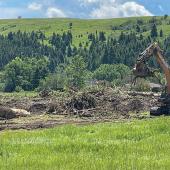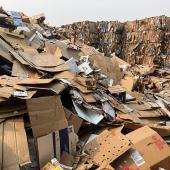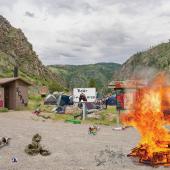Enduring Energy
The old West was built on logging, mining, and ranching, and the New West is being built on tourism, technology, and the “amenity” economy—or so the conventional wisdom goes. Extraction is out, recreation is in, and if we can just stop fighting last year’s environmental wars and get on with it we’ll all be healthier and wealthier in the long run.
Yet this simple formulation ignores the little business called energy, which may prove to have more impact on the Rocky Mountain West over the coming decades than any other industry. Already, in Wyoming, oil and gas development is transforming the state’s landscape—and its finances. In Montana, Governor Brian Schweitzer is advocating coal gasification as a green-ish way to exploit the state’s immense coal reserves. In Colorado and Utah, massive oil shale projects are again on the table. Up north, in Alberta, what may be a decades-long economic boom (and, some say, an environmental disaster) is now getting cranked up around oil sand development. And windmills are sprouting just about everywhere.
Energy is an emotional issue. It’s so elemental. It’s so wrapped up in the history of the West, and so important not just to the region but also to the world. Butte, Montana boomed on global demand for its electricity-conducting copper—and early in the last century was among the biggest (and most electrified) cities in the West. The Montana Power Company was an economic jewel of the state until it was destroyed by one of the worst set of strategic decisions in the history of American business. Now a consortium of Montana cities, led by former Missoula Mayor Mike Kadas, is trying to buy the power grid and make it a public utility. It is, in part, a matter of pride.
The dams that lace the West were built partly for irrigation, it’s true, but they were also built to generate power. And that cheap electricity was once an economic engine of its own, attracting aluminum smelters and other manufacturers and helping to win more than one war. Even the little Milltown Dam above Missoula, which will come down as part of the remarkable project to clean the Clark Fork River, still feeds a little power to the grid. Hydropower development was a driving force in the West for much of the 20th century, and when you start talking about taking down dams to help the fish, well, people have strong feelings about it.
Coal, which most Americans would be surprised to know is the source of more than half of all the electric power generated in America, still exists in extreme abundance in the West, especially in Wyoming and Montana. For the most part it’s not located in the most environmentally sensitive spots. Using those reserves to cut our dependence on foreign oil is only common sense—except for the little matter of global warming. Whatever the politicians might say, most people in the Mountain West know from direct experience that the climate is changing. But it’s still hard to put the environment in front of the nation’s energy needs, and dozens of traditional, polluting, coal-burning power plants are now on drawing boards around the West.
Coal-bed methane development, meanwhile, is going straight to the heart of the two things most likely to get a Westerner riled up: property rights and water. The need to drill many small wells has brought unprecedented conflict over so-called split estates, where the owner of the land is not the same as the owner of the sub-surface mineral rights. Wyoming ranchers, not generally known for their environmental sensitivities, are up in arms, and managed to push through a new law that gives surface owners a few more rights. But even if that issue can be managed, there is no easy solution to the problem of CBM wastewater and how to dispose of it without damaging rivers and ranches.
In some respects, energy development divides Westerners along traditional lines: anti-regulation Republicans versus environmentalists. This is exacerbated by the sense that the Bush Administration, not least because of Wyoming Vice President Dick Cheney’s influence, is far too eager to do the bidding of the energy companies. The recent Energy Bill was seen as a bad joke not only by environmentalists, but also by many people who take the common-sense view that conservation needs to be an important part of any energy policy.
Yet there are also many ways in which energy issues cut across the traditional divides, and that could be an opportunity. Yes, let’s exploit the coal reserves, but let’s also take the lead in developing clean-coal technologies. Let’s drill for gas, but let’s also make sure that regulations require the use of the best technologies to minimize surface disruptions—and that fly-by-night operators are not allowed to leave big messes behind. In short, let’s be smart about it, and mine our energy riches in a way that produces long-term economic benefits, not just a short-term boom. That means, among other things, doing it in an environmentally sound way—for the amenity economy, remember, will also be here for a long time to come.
10 Easy Energy-Saving Tips for Your Home
1. Caulk, seal, or weatherstrip leaks around windows and doors. Test by holding incense near potential drafts on a windy day while watching the smoke. Saves up to 10 percent of heating costs.
2. Open drapes in the morning, particularly those south-facing, and let the sun heat your home for free. Draw closed again at sundown.
3. Make flannel or other heavy-insulating curtains.
4. Keep fireplace damper closed when not in use. Otherwise, it’s like having the window open.
5. Use cold water in your washing machine. Reduces washer’s energy use by 75 percent.
6. Cover liquids and wrap foods stored in refrigerator. Uncovered foods release moisture and make the compressor work harder.
7. Replace or clean furnace filters. Saves up to five percent of heating costs.
8. Reduce water heater temperature to 120 degrees. Saves up to 11 percent of water heating costs.
9. Wrap hot water tank with jacket insulation. Saves up to 10 percent of water heating costs.
10. Unplug TVs, VCRs, toasters, computers and printers, and other appliances that use electricity even when they are switched “off.” Five percent of the electricity consumed in the U.S. is lost to “vampire” electronics.
Source: U.S. Department of Energy.
—Lucia Stewart












